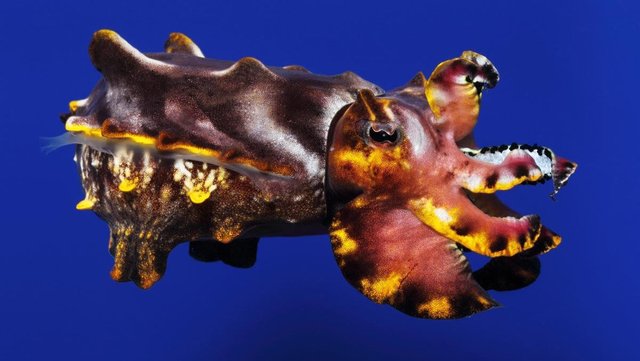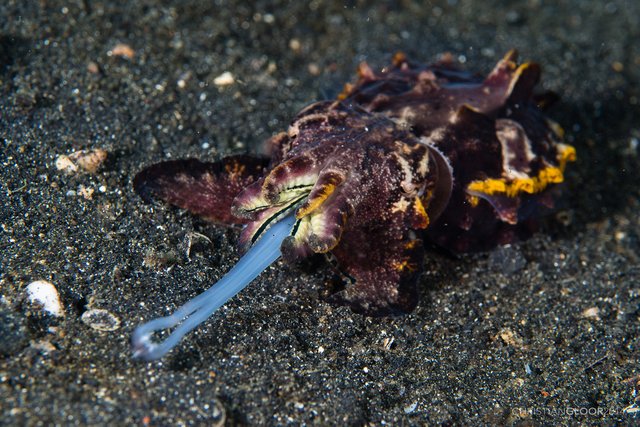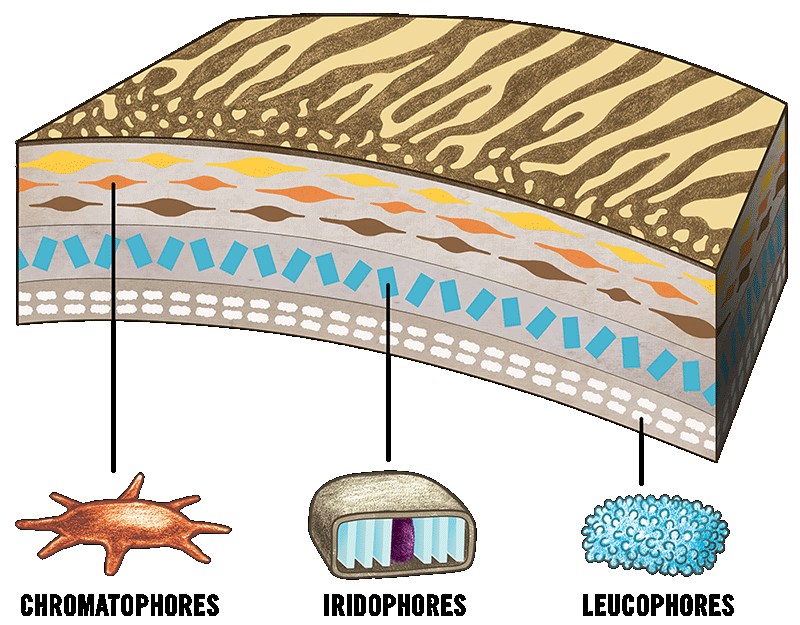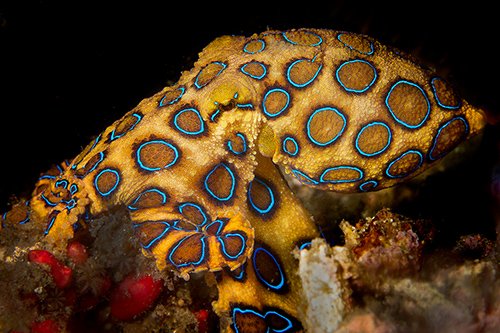Amazing Animals #27 The Flamboyant Cuttlefish
As a young child I always had the dream of one day becoming a marine biologist, various different life events and changes in interests gradually reduced my focus on this dream, partner that with the fact that I’m a weak swimmer and am not overly comfortable if I can’t see the seafloor and I can safely say that I’m happy to be a Zookeeper… on dry land.
Despite this I still have a keen interest in aquatic species and often wonder what it would be like to work in an environment where new discoveries are made on an almost daily basis, the variety of life within our Oceans is also unparalleled compared to any other Biome, a particular interest of mine are the Cephalopods.
Cephalopods are intelligent, come in many shapes and sizes and are truly marvels of evolution with some Orders remaining relatively unchanged for hundreds of millions of years, the flamboyant Cuttlefish is an interesting example of the order Sepiida (Cuttlefish) and are a worthy animal to represent the first Cephalopod of this series.
Description
The flamboyant Cuttlefish (Metasepia pfefferi) are a stunningly beautiful species of cuttlefish are a great example of the weird and wonderful routes evolution can take, Cuttlefish in general are quite peculiar animals so I feel it would be beneficial to go over the basic traits of their Order whilst including details on the Flamboyant Cuttlefishes specific traits along the way.
All Cuttlefish have 8 arms located at the front of their body, accompanying these 8 arms are two tentacles that act as the Cuttlefishes main form of offense when hunting prey, both the tentacles and the arms are adorned with denticulated (toothlike) suckers which effectively grasp their prey, the tentacles are generally 3-4 times longer than the arms and can be extended rapidly thus allowing the Cuttlefish to be quite the ambush predator.
The Eyes of any Cuttlefish are very different from our own in their appearance, all Cuttlefish possess large eyes in relation to their body-size and have a W/Cup shaped pupil at the centre, the pupil is often outlined with a thin Iris that differs in colour from species to species, the Flamboyant Cuttlefishes eyes don’t quite stand out as much as at a glance they blend in seamlessly with their vivid colouration and ridged body shape.
Their eyes may appear somewhat similar to those of Vertebrate species though they are anything but, they do not have the ability to see in colour but are able to perceive the polarization of light thus enhancing their capability to distinguish contrast, the structure of their eyes is quite strange, they have two sensory cells called Foveae on their Retina, one looks backwards, the other forwards.
Our own eyes alter our focus by reshaping the lens, the Cuttlefishes eyes do not have this capability, instead the entire lens is shifted toward or away from the Retina, their eyes are also assembled in a “perfect” manner, with the entire optic nerve behind the retina as opposed to our own which is both behind and in front which creates blind spots, the Cuttlefishes optic nerve generates no blind spots and they are able to look both forwards and backwards simultaneously, sneaking up on a Cuttlefish is a difficult task!
Cuttlefish comes in a variety of shapes and sizes, coincidentally one of the smallest species of Cuttlefish is the flamboyant Cuttlefish, on average they measure just 8 cm’s in total body length (tentacles retracted) and weigh around 300-400 grams when fully matured, this is tiny compared to the largest species the Australian giant Cuttlefish (Sepia apama) which grow to 0.5 metres long and can weigh as much as 11.5 kg’s.
The largest part of the Cuttlefish is known as the mantle, the mantle is the entire section of the body behind the head, in Cuttlefish the mantle is often frilled or has visible lateral flaps, these flaps can be moved to aid in swimming, the primary function of the mantle is to house essential organs and to act as the Cuttlefishes primary source of locomotion, the Cuttlefish inhales water in to the muscular mantle and then rapidly expels the water through the Siphon, thus effectively functioning as form of jet propulsion.
The mantle of the flamboyant Cuttlefish has three pairs of fleshy ridges known as papillae on the dorsal side of their mantle as well as a V-shaped ventral (underside) ridge, they also have a pair of papillae over their eyes, the overall function of the papillae is to break the outline of the flamboyant Cuttlefish, the tips of the lateral flaps, as well as the papillae are often bright yellow in their colouration.
All Cuttlefish possess an internal structure within the mantle called the Cuttlebone, the Cuttlebone is not the same as a backbone despite running the length of their body so they are still Invertebrates, it is made out of a material called Argonite and is porous and chambered, the main function of the Cuttlebone is to control buoyancy as they do not possess a swim bladder and are therefore reliant on gas/liquid exchange within the Cuttlebone.
The Cuttlebone is technically an internal shell and functions much in the same way as the shells of other chambered-shell cephalopods, along the ventral line of the Cuttlebone is a thin strand of tissue known as the Siphuncle, the Siphuncle connects all of the chambers within the Cuttlebone, the Siphuncle allows liquid to be expelled from the chambers, in doing so the Cuttlefish experiences improved buoyancy, however this process is not overly efficient and they are unable to rise or sink at will.
The Cuttlebone of the flamboyant Cuttlefish is relatively small compared to other species and is on average only two thirds to three quarters the length of its mantle, it is also lacking an outer cone which is observable in the majority of Cuttlefish species, due to its small size it cannot float for prolonged periods of time and therefore it can normally be found on the seafloor.
Their circulatory system is interesting and much the same as most other Cephalopods which I’d rather cover in more detail as a topic in itself, just for quick facts they have three hearts with one heart for each gill, and a single heart for the rest of the body, each of these systems are separate from one and other and their blood is blue as a result of their blood containing Hemocyanin as opposed to Hemoglobin!
Cuttlefish are quite strange animals with regard to their geographic range, they are present in temperate/tropical waters and frequently inhabit coastlines across western Europe, east/southern Asia, throughout the Mediterranean, and every coastline of Africa and Australia, despite this massive range they are completely absent from northern, central and southern coastlines of the Americas.
The Flamboyant Cuttlefish can be found in the tropical shallow waters of northern Australia and southern New-Guinea, scattered populations can also be found in the coastal waters of various Philippine islands, Indonesia and Malaysia, they prefer to inhabit sandy/muddy terrain that offers ample camouflaging opportunities.
Behaviour, Colour and Communication
The behaviour of the flamboyant Cuttlefish is quite peculiar and unique as they are the only species of Cuttlefish currently known to live a “grounded” existence, they effectively use their arms as well as their ventral ridge to walk along the seafloor as opposed to swimming, their normal base colour is a generally uniform dark brown, this, along with their jagged outline can lead to the animal appearing much-like debris rolling across the seafloor.
They are diurnal predators meaning they are active throughout the day, they exhibit stalking behaviour when hunting and they actively alter their colouration to blend in with the environment that they are in, in this sense the Cuttlefish is an ambush predator, their two main methods for catching prey are stalking, and baiting, whereby the Cuttlefish may remain in the same location for prolonged periods of time whilst altering the colouration of their arms and also moving them in a way that may mimic a prey animals food source (for instance Algal strands), once attracted the Cuttlefish can lunge the unsuspecting prey from close range thus ensuring a high degree of success.
Whilst the Cuttlefish has arguably the most advanced form of natural camouflage in the world, they are still vulnerable to larger predators such as other Cephalopods (including Cuttlefish), Sharks and large bony Fish, the Flamboyant Cuttlefish is quite a fragile animal, though it's toxicity which will cover later, is enough to dissuade even the boldest of predators.
Their diet consists primarily of small Crustaceans, Bony Fish and Molluscs, they are equipped with a sharp beak that is capable of ripping, tearing or smashing hard-shelled animals, they are obligate Carnivores.
By far their most interesting behavioural traits are associated with their ability to alter their colouration as well their visible texture at will as their primary method of communication and also offers a form of adaptive camouflage when hunting or avoiding predation, their incredible ability to alter their colouration is known as "rapid neural-polyphenism", we'll refer to it simply as polyphenism.
Polyphenism is achieved as the Cuttlefish possesses several anatomical cell structures layered on top of one and other that are also connected to a complex neural network, the cells are namely Chromatophores, Iridophores and Leucophores.
Chromatophores are the most notable cell and the are essentially an organ within the Cuttlefishes skin, each Chromatophore resembles a sac that contains thousands of pigment granules which are surrounded by neurologically-controlled radial muscle fibres, as the muscles expand the pigment granules become exposed which allows a particular hue (predominantly yellows, oranges and browns) to be represented on their skin.
It is only when the muscle fibres connecting to the Chromatophores are retracted that the reflective layers of Iridophores and Leucophores become exposed, the iridophores can convey a variety of iridescent blues and greens, where as the Leucophores display a combination of high-contrast whites.
The Cuttlefish possesses millions of Chromatophores across its body and each one can be controlled individually, this allows them to display complex patterns and sequences that are quite simply mind-blowing to observe, it is now believed that many of the visual displays that they are capable of producing are instinctive and function automatically when exposed to a certain situation.
A 2016 study on the behaviours of captive-bred flamboyant Cuttlefish categorised the four main forms of communication (components) as Textural (smoothness of the skin, emergence/reduction of papillae), Postural (positioning of all body parts), Locomotive (movement or rest) and Chromatic (consistent and independent grouping of altered colouration), the study concluded that the flamboyant cuttlefish displays between 42 and 75 chromatic components, 7 locomotive components, 14 postural components and 7 textural components, combined this means that the flamboyant Cuttlefish has roughly twice as many communication components (103) as the next closest species, the common Cuttlefish (Sepia officinalis)(55), this finding may be a result of how the tests were conducted and categorised, the study concluded:
Using maximum likelihood analysis and AutoClass@IJM software, we found that these components combine to generate 11 distinct body patterns. The software was able to sort 98% of the live animal observations into one of the 11 patterns with 90% confidence and 88% of observations with 99% confidence. Unusually for cuttlefish, 8 of the 11 identified patterns contained at least one “traveling” component (i.e., traveling waves or blinking spots) in which the colours on the skin appeared to travel on the animal’s mantle.
This indicates that 11 patterns are synonymous with the flamboyant Cuttlefish and are likely an automated response to a variety of specific scenarios ranging from post-hunting behaviour (vibrant colouration with a mixed pattern) to threatened behaviour (increased focus toward high contrast and luminous colours), this effectively functions as a hidden language embedded in to the animal which allows them to communicate with one and other in displays of aggression, courtship and submission, their polyphenism can also be employed to signal to would-be-predators that they are poisonous and are not suitable for consuming, it has also been theorised that it can be used as a method of hypnosis when hunting prey.
Interestingly the Cuttlefish is also capable of adaptive camouflage whereby they can mimic the colour and texture of their surroundings, this is achieved via visual observations though is made all the more remarkable as we have to remember that they are completely colour blind, furthermore they can also adapt to their surroundings in complete darkness.
Much is still unknown as to how they are capable of such accurate determination and mimicry of colour, though it is theorised that by altering the position of the lens in their eye they can detect colour via Chromatic aberration, thus allowing them to identify specific individual wavelengths of light, however, more research is required before this can be considered entirely factual, many mysteries still surround these amazing animals!
Note: Some of the most interesting Cuttlefish behaviour can be observed in their reproductive behaviour, this however would be a giant Rabbit hole to venture in to and i'd rather keep this post at the average length for my normal posts, I will however add it to my list of things I'd like to write about as a solitary topic!
Toxicity
As mentioned previously the flamboyant Cuttlefish are able to change their colouration in a variety of ways to dissuade potential predators, this is not mere mimicry as the flamboyant Cuttlefish is a highly toxic creature, until recently they, along with their close relative Metasepia tullbergi were thought to be the only toxic Cuttlefish species, recent findings have however also classified Sepia bandensis and Sepia officinalis as toxic.
More specifically the muscles themselves contain a poisonous toxin, they along with the three other mentioned Cuttlefish are the only species of Cephalopod currently known to science to exhibit this trait of poisonous flesh, there are two other Cephalopods known to be poisonous/venomous, the striped pyjama Squid which is thought to exhibit poisonous mucous, and the Blue-ringed Octopus (four species) which is known to possess a venomous bite.
Both of these toxins consist predominantly of the neurotoxin Tetrodotoxin which is roughly 1200 times more toxic than Cyanide and is the primary toxin of the three other Cuttlefish species, it is also commonly found in the organs of various species of Pufferfish, however the toxin found in the flamboyant Cuttlefish is not Tetrodotoxin.
The toxin found in the flamboyant Cuttlefish is incredibly rare in nature, and until its discovery, had never been previously observed, this means that the flamboyant Cuttlefish has a poison that is entirely unique from any other organism on the planet and from what I can see the poison is still uncategorized as of 2018, if anyone knows more I’d be intrigued to hear it!
Intelligence
Despite their size, Cuttlefish are surprisingly intelligent animals that have exceeded all expectations when observed, consider that the flamboyant Cuttlefish regularly only measures 3 inches in length, that doesn’t leave a lot of room to store a brain capable of complex function, though they do have the advantage of having the largest brain to body ratio of any invertebrate (along with Octopus and Squid).
It’s clear from examining the behaviour of Cuttlefish that they are capable of communicating with their surroundings, and that they are also able to process vast swathes of information in a short period of time, as is observed in their ability to alter their appearance and colouration to adhere to the environment or situation they are in.
Intelligence in Cephalopods is however not new or exciting information, complex tests of logic and reasoning have been conducted on various species of Octopus with frequently amazing results, it is clear that the mental capacity of Cephalopods is higher than that of most animals within the Ocean, as well as many terrestrial animals.
In my previous article I mentioned how Kodiak Bears are capable of learning and exhibiting trained behaviours so long as they are taught using positive reinforcement methods, this is true of most animals regardless of the size of their brain, if you feed any animal straight after using a clicker it will more often than not associate the clicker with food.
In the case of my late Bearded Dragon Spyro she associated a yellow tray as an indication that she’d receive treats and would immediately become excited, I feel true intelligence is leaving an animal to its own devices and observing whether or not it can solve a problem for itself, either in a blind test chamber, or by observing an animal that has been taught the behaviour required to solve the problem, in short the ability to learn to adapt to new situations to achieve a favourable outcome.
Less research has been conducted in to the intelligence of Cuttlefish when compared to the Octopus though anatomically they are quite similar and are theorised to have similar mental capabilities, a 2016 study also found that Cuttlefish have a profound ability to count, roughly comparable to the abilities of a toddler, this was demonstrated by offering the Cuttlefish multiple feeding choices and seeing whether or not the animal was capable of choosing the most rewarding option, the study states:
Using this visual attack behaviour as a measure, cuttlefish showed a preference for a larger quantity when faced with two-alternative forced choice tasks (1 versus 2, 2 versus 3, 3 versus 4 and 4 versus 5). However, cuttlefish preferred the small quantity when the choice was between one live and two dead shrimps. More importantly, when the choice was between one large live shrimp and two small live shrimps (a prey size and quantity trade-off), the cuttlefish chose the large single shrimp when they felt hunger but chose the two smaller prey when they were satiated.
These results are incredibly interesting as they display that the Cuttlefish not only possesses number recognition (potentially greater than 5), but they are also capable of determination of quality that is dictated by their current metabolic requirements which is a great example of an animals ability to employ logic and reasoning within their decision making, for a group of animals often no larger than 20 centimetres in length their cognitive ability is nothing short of incredible and i'm sure we'll continue to learn more in the coming decades.
Content Sources
- Jet Propulsion in Cephalopods
- Number Recognition in Cuttlefish
- Communication in Captive Metasepia pfefferi
- Visual interpolation for contour compeltion by Cuttlefish
- Monterey Bay Aquarium information on Flamboyant Cuttlefish
More Amazing Animals
If you enjoyed this article you may enjoy some of the previous animals I have covered!
- The Kodiak Bear
- The Jumping Spiders
- The Ocean Sunfish
- The Leatherback Sea Turtle
- The Fruit Bats
- The African Elephant
- The African Lion
- The Arctic Fox









I knew that they had to rely on gas exchange for buoyancy and that they, like belemnites, had a hard structure to help with this. I never knew it was called a cuttlebone though. That's neat! My marine biology professor didn't go into specifics of the cuttlefish since he was more of a shark person and wanted to get to them asap.
You definitely do not want one of these to bite you.
Thanks for posting this. I learned quite a bit about these magnificent creatures from this that I should have probably been taught doing my lectures. :)
I'm still quite regretful that I didn't pursue a career in Marine biology, there is definately a lot still to be discovered in our Oceans, are you in the profession? :)
I am suprised about the Cuttlebone being missed as a point of discussion (though Sharks are awesome!), as far as I'm aware Cuttlefish are the only Cephalopods that possess an internal shell to control buoyancy.
Squid and the non-related Vampire Squid also have internal shells known as a Gladius that is made out of Chitin, though these function as a support structure for connecting muscles within the mantle.
I'm a 3rd year marine science major. It's never too late to pursue that career!
The spirula also has an internal shell to control buoyancy as well. I think they're the only two (discovered) alive today.
Oh that's cool, do you have any specific interests within the subject? I've always imagined working with Sharks (at a safe distance) would be a cool and fulfilling job.
That's very true! It's a thought that enters my mind occassionaly, though I love the work I'm involved in right now so it will likely remain just a thought. :)
Oh that's right, gonna have a read up on them! There could be many more out there, it's difficult to actually grasp just how vast our Oceans are.
I like marine geology and the physics side of marine science so far (like physical oceanography). I plan on becoming a marine engineer so I think it's a good thing I enjoy those.
This instagram is run by my marine biology professor and some of his graduate students. Might be worth checking out if you like sharks.
You can still find crews to go out with and get a taste of that marine biologist life.
Yeah, I thought about studying marine biology as well, but ultimately went the zoology route. Which is possibly a good thing as I seem to get more and more seasick nowadays, so a life of research on the ocean was going to be unpleasant :/
Still love diving though, and Cephalopods are pretty much my favourite thing to see. I couldn't eat calamari for years after spending some time in the company of Caribbean reef squid after one of my first dives
To detail just how unsuited I am for it, I went on my first dive last year and vomited multiple times into my regulator, entering the water almost made my seasickness worse, and i felt nauseous for the next 12 hours!
They are an inquisitive group of animals and you can definately tell that there is a thought process occuring when observing them, maybe if I can find the right tablets I may get to see them in the wild one day.
Ah interesting, so going under didn't stop the queasiness? Usually I'm fine once my head is under water.
It most definately did not! :D
I put it down to the fact I think I was too far gone by the time we reached the dive-site.
I've had dives like that :( My first couple of dives in Galápagos I was so seasick (despite having taken tablets) that I was throwing up until we got in the water. I was still fine once under, but the second we were up and bobbing, waiting for the boat, I got queasy and 2 mins back on board, did me in completely. It was a full day diving so yeah, not much fun. Even worse was that the visibility was awful and I missed a manta ray while clearing my mask 😑
This post has been upvoted and picked by Daily Picked #8! Thank you for the cool and quality content. Keep going!
Don’t forget I’m not a robot. I explore, read, upvote and share manually :)
A lot of work went into this post and I can feel the deep interest you have into this fascinating species family.
What makes the post a bit hard to read is the length of your sentences. May I suggest that you try to keep sentences a bit shorter for future posts? Otherwise a very instructive article.
Well done.
I try to limit the general length of my sentences though I am guilty of over-extending, and occassionaly rambling, I get carried away sometimes!
My main goal is to share what I'm passionate about with whoever may come across my articles, and ease of reading is definately important.
I'm always open to constructive criticism and I'll keep it at the forefront of my mind for future posts. :)
Is there maybe some color pattern that Cuttlefish cannot camouflage?